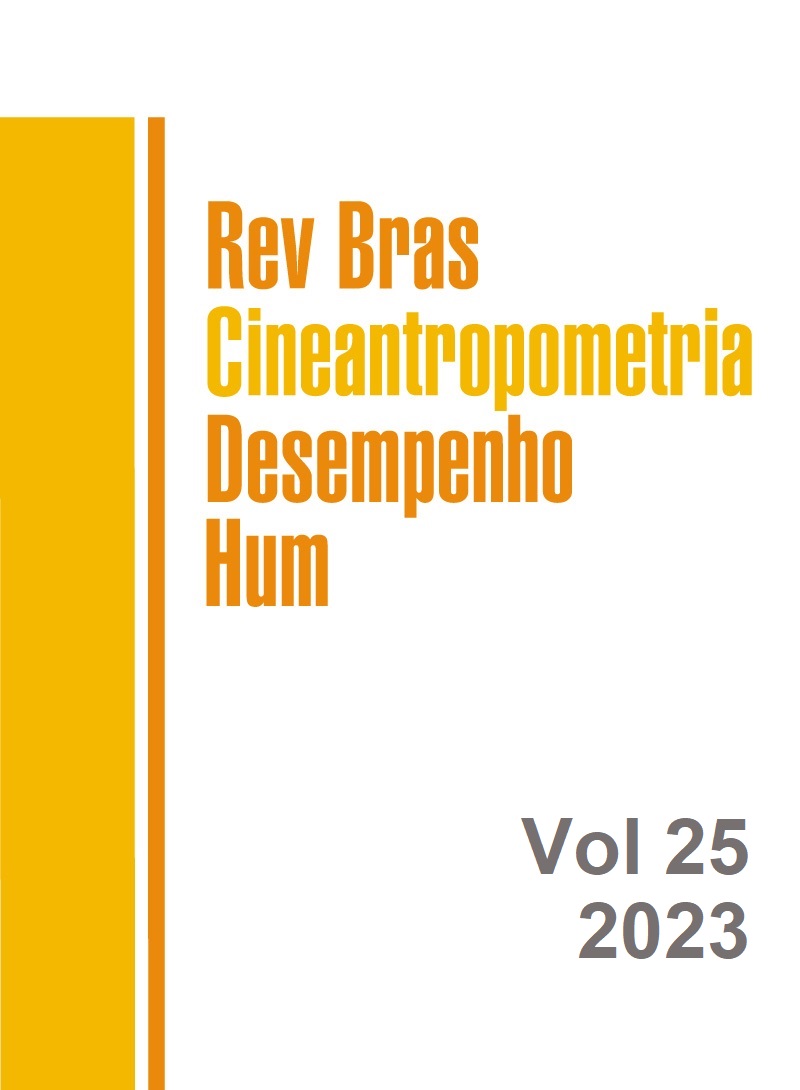Idade relativa em nadadores e paranadadores brasileiros
DOI:
https://doi.org/10.1590/1980-0037.2023v25e90990Palavras-chave:
desempenho atlético, Natação, Coorte de nascimentoResumo
Este estudo teve como objetivo analisar as relações entre eventos competitivos de natação, classificação funcional e idade relativa e detectar se a idade relativa afeta o desempenho em nadadores e paranadadores brasileiros. Os dados foram recuperados de bancos de dados públicos e as datas de nascimento foram classificadas em quatro quartis (Q1 = janeiro-março; Q2 = abril-junho; Q3 = julho-setembro; Q4 = outubro-dezembro). Utilizou-se estatística descritiva, teste Qui-quadrado e ANOVA. Os 50 m livre é a prova competitiva com 2.349 nadadores, seguido de 100 m (n = 1.817) e 200 m livre (n = 905), e 200 m borboleta com 42 nadadores. Os paranadadores estão distribuídos principalmente nas classes funcionais S14, S6 e S5 (n = 140, 87 e 45), e as provas individuais de medley foram menos representadas em SM3, SM9 e SM11 (n = 1 nadador). A maioria das provas de natação (86,36%) e classes funcionais de paranatação (51,43%) são representadas por nadadores e paranadadores nascidos no primeiro e segundo quartis. Associações moderadas entre classificação funcional e idade relativa foram observadas (p < 0,0001, V de Cramer = 0,277). Não foram observados efeitos da idade relativa no desempenho de nadadores e paranadadores (p > 0,05). A grande classe funcional parece estar relacionada com a idade relativa dos grandes paranadadores. A distribuição por quartis mostra a vantagem de ter nascido nos primeiros meses do ano para ser registrado entre os mais talentosos nadadores e paranadadores brasileiros.
Referências
Smith KL, Weir PL, Till K, Romann M, Cobley S. Relative Age Effects Across and Within Female Sport Contexts: A Systematic Review and Meta-Analysis. Sports Medicine. 2018 Mar 13;48(6):1451–78.
Cobley S, Abbott S, Dogramaci S, Kable A, Salter J, Hintermann M, et al. Transient Relative Age Effects across annual age groups in National level Australian Swimming. Journal of Science and Medicine in Sport. 2018 Aug;21(8):839–45.
Wattie N, Schorer J, Baker J. The Relative Age Effect in Sport: A Developmental Systems Model. Sports Medicine [Internet]. 2014 Aug 29;45(1):83–94. Available from: https://link.springer.com/article/10.1007/s40279-014-0248-9
Sandercock G, Ogunleye A, Parry D, Cohen D, Taylor M, Voss C. Athletic Performance and Birth Month: Is the Relative Age Effect More than just Selection Bias? International Journal of Sports Medicine. 2014 Jun 2;35(12):1017–23.
Nagy N, Földesi G, Sós C, Ökrös C. Talent Selection and Management in View of Relative Age: the Case of Swimming. Physical Culture and Sport Studies and Research. 2018 Dec 1;80(1):57–67.
Ferriz-Valero A, García Martínez S, Olaya-Cuartero J, García-Jaén M. Sustainable Sport Development: The Influence of Competitive-Grouping and Relative Age on the Performance of Young Triathletes. Sustainability. 2020 Aug 21;12(17):6792.
Brustio PR, Lupo C, Ungureanu AN, Frati R, Rainoldi A, Boccia G. The relative age effect is larger in Italian soccer top-level youth categories and smaller in Serie A. Ardigò LP, editor. PLOS ONE. 2018 Apr 19;13(4):e0196253.
Lorenzo-Calvo J, de la Rubia A, Mon-López D, Hontoria-Galán M, Marquina M, Veiga S. Prevalence and Impact of the Relative Age Effect on Competition Performance in Swimming: A Systematic Review. International Journal of Environmental Research and Public Health. 2021 Oct 9;18(20):10561.
de la Rubia Riaza A, Lorenzo Calvo J, Mon-López D, Lorenzo A. Impact of the Relative Age Effect on Competition Performance in Basketball: A Qualitative Systematic Review. International Journal of Environmental Research and Public Health. 2020 Nov 19;17(22):8596.
Costa AM, Marques MC, Louro H, Ferreira SS, Marinho DA. The relative age effect among elite youth competitive swimmers. European Journal of Sport Science. 2013 Sep;13(5):437–44.
Brustio PR, Boccia G. Corrective procedures remove relative age effect from world-class junior sprinters. Journal of Sports Sciences. 2021 Jul 1;1–8.
Abbott S, Moulds K, Salter J, Romann M, Edwards L, Cobley S. Testing the application of corrective adjustment procedures for removal of relative age effects in female youth swimming. Journal of Sports Sciences. 2020 Mar 21;38(10):1077–84.
Bezuglov E, Shoshorina M, Emanov A, Semenyuk N, Shagiakhmetova L, Cherkashin A, et al. The Relative Age Effect in the Best Track and Field Athletes Aged 10 to 15 Years Old. Sports. 2022 Jun 28;10(7):101.
Hogarth L, Nicholson V, Payton C, Burkett B. Modelling the age‐related trajectory of performance in Para swimmers with physical, vision and intellectual impairment. Scandinavian Journal of Medicine & Science in Sports. 2021 Jan 7;31(4):925–35.
Fulton SK, Pyne DB, Hopkins WG, Burkett B. Training Characteristics of Paralympic Swimmers. Journal of Strength and Conditioning Research. 2010 Feb;24(2):471–8.
International Paralympic Committee. World para swimming classification rules and regulations. International Paralympic Committee. 2017.
Nawacki Ł, Matykiewicz J, Stochmal E, Głuszek S. Splanchnic Vein Thrombosis in Acute Pancreatitis and Its Consequences. Clinical and Applied Thrombosis/Hemostasis. 2021 Jan 1;27:107602962110102.
Cohen J. Statistical power analysis for the behavioral sciences. 2nd ed. Hillsdale, N.J.: L. Erlbaum Associates; 1988.
Barnsley R , Thompson A , Barnsley P . Hockey success and birthdate: The relative age effect. Journal Canadian Association for Health Physical Education and Recreation. 1985; 51: 23–28.
Gil SM, Bidaurrazaga-Letona I, Larruskain J, Esain I, Irazusta J. The relative age effect in young athletes: A countywide analysis of 9–14-year-old participants in all competitive sports. Gonçalves B, editor. PLOS ONE. 2021 Jul 16;16(7):e0254687.
Allen SV, Vandenbogaerde TJ, Hopkins WG. Career performance trajectories of Olympic swimmers: Benchmarks for talent development. European Journal of Sport Science. 2014 Mar 6;14(7):643–51.
Baker J, Janning C, Wong H, Cobley S, Schorer J. Variations in relative age effects in individual sports: Skiing, figure skating and gymnastics. European Journal of Sport Science. 2012 Apr 23;14(sup1):S183–90.
Downloads
Publicado
Edição
Seção
Licença

Direitos Autorais para artigos publicados nesta revista são do autor, com direitos de primeira publicação para a revista. Em virtude da aparecerem nesta revista de acesso público, os artigos são de uso gratuito, com atribuições próprias, em aplicações educacionais e não-comerciais, desde que seja dada a atribuição. Esta obra foi licenciada com uma Licença Creative Commons Atribuição 4.0 Internacional - CC BY


